“Reaping the Rewards” is a series about crowdfunded projects after they’ve come to fruition. Today I look at the finished version of Between Two Cities, which was funded in March 2015 and shipped to most backers in October (a little bit early!).
Between Two Cities is for 1 to 7 players, ages 8 and up, and takes about 20 minutes to play. It retails for $35, and there are limited numbers of the Special Edition available for $49. It was designed by Ben Rosset and Matthew O’Malley, and published by Stonemaier Games.
Dave Banks and I reviewed Between Two Cities during the Kickstarter campaign, so you can check out that post for more details about how the game works. I’ll focus on the differences between the prototype and the final product.

Components
- 108 Building tiles
- 24 Duplex tiles
- 14 City tokens (7 pairs)
- 1 Scoreboard
- 15 Seating Randomizer cards
- 7 Reference cards
- 20 Automa cards
- 3 Name cards
The Special Edition also includes 14 additional City tokens, plus rulebooks in German and French in addition to the English rulebooks. The box for the Special Edition has gold trim and each box is numbered. The gameplay is not affected by the Special Edition.

The city tiles are nice, with a purple background on the single building tiles and a yellow background on the duplex tiles. Sturdy cardboard, icons to supplement the illustrations (particularly useful for color-blind players), and each has a scoring reference at the bottom.

One of the stretch goals was to have some variety in the artwork, so not all of the buildings of a set looked exactly the same. You can see some differences–foliage in front of the houses, and the entrances to the taverns, for instance–but these are pretty slight variations. For the most part, unless you’re looking closely, all the office buildings look like each other, all the factories look the same, and so on. I know one of Dave Banks’ primary critiques of Between Two Cities was that he didn’t care for the artwork, and the final version isn’t significantly different from the prototype.
I don’t feel as strongly about the artwork myself–I’ll play a game even with no artwork if I enjoy it–but it’s not one of those games that wows me with its beauty. If it looked more like the box cover, that would be a bit more exciting.
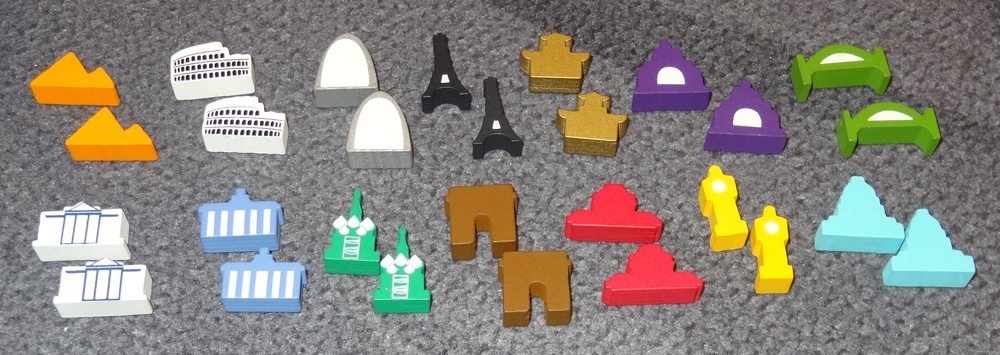
The city tokens are custom meeples, each representing an iconic building from a city–the great Pyramids, the Arch, the Eiffel Tower, and so on. The Special Edition includes 7 more sets pairs of these meeples, just to give you a bigger variety to choose from.

The scoreboard, made to look like a bunch of fields, is double-sided. You can either have one that zigzags up, or one that goes left to right for each row. Apparently some people were dead set on the zigzag version, and some insisted on the other version, so you get both. Personally, I like the left-to-right version because it makes it easier to add 10 by moving straight up, and I think it makes it easier to tell relative scores at a glance. But to each his own.

The Seating Randomizer cards are a new addition. The backs show a top-down view of six people seated around a table (you can see it in the components photo above). The cards are numbered, and each gives some criteria for seating order around the table: by height, alphabetical by city of birth, and so forth. It’s not entirely necessary, but if you’re going to play multiple games of Between Two Cities it’s a good idea to mix it up between games because of the drafting aspect–plus it’s a fun way to learn some new facts about people. You could even use these cards for just about any game, so I might pull them out of the Between Two Cities box and just keep them handy for game nights.
Between Two Cities is one of the rare instances when I might argue that the box is too small for the game. It’s a medium-sized square box, smaller than something like Ticket to Ride, and I can get everything inside but it’s a tight fit. It either needs a slightly larger box or some sort of insert, because having that many loose tiles just means that they slide all around. I’ve made it work by putting all the square tiles in a large baggie, the tokens in another small bag, and then the cards and duplex tiles just sorted off to one side, but it can be tricky to put away properly. Still, I’d rather have this box than up to a standard square box, which would be too big.
How to play
There weren’t any changes in base gameplay between the prototype and finished version, so you can refer to Dave’s post for that. The new addition between the prototype and the final game is that the two variants are now available: 2-player and solo.
The 2-player game is easier to explain, and doesn’t require any additional components.
You and your opponent each build two cities on your own. When you pick tiles, you pick one for each city, and then pass the remaining tiles across to your opponent. Since you aren’t working with partners on your cities, you’ll play twice as many rounds (so you still end up with 16 tiles each in the finished cities). Your score at the end is the sum of the two cities rather than the lower of the two.
Since there’s no cooperation whatsoever in the 2-player variant, deciding which tiles to pass to your opponent becomes more important in your strategy, and it also feels a bit more cutthroat instead of the semi-cooperative game with more players. You’ll find yourself paying more attention to those other cities, rather than focusing mostly on your own two cities.
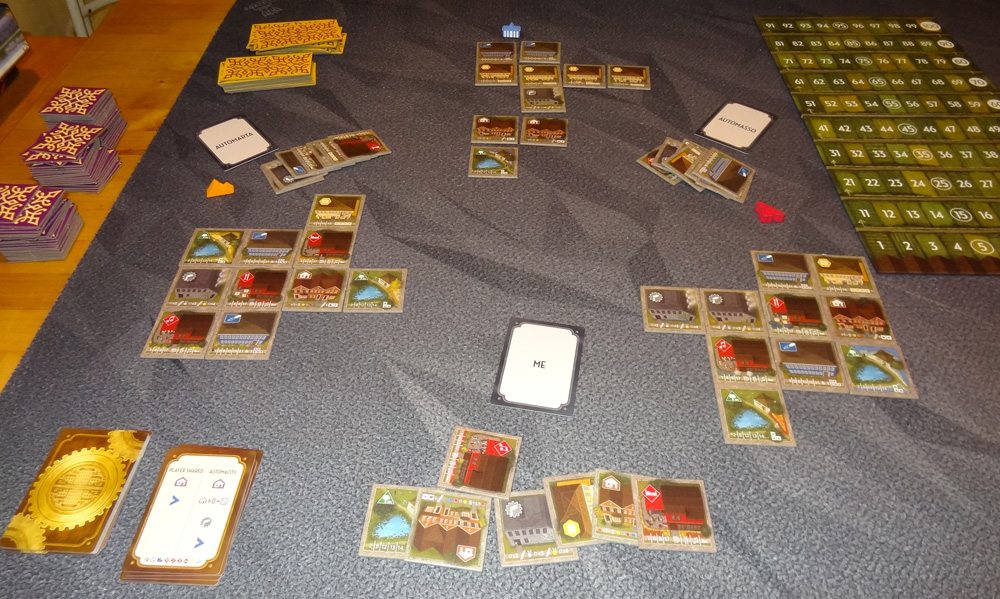
The solitaire version was designed by Morten Monrad Pedersen. Solo play acts like a 3-player game, with two simulated players called “automas”: you build one city with Automarta, one with Automasso, and the two automas build a city between them. There are two solitaire modes, Simple and Full.
Simple doesn’t require additional components. Basically each turn you’ll draw one tile per city and place those face up–those are the tiles chosen by the Automas. Then you draw three tiles, and assign one to each city. Once tiles are chosen, you add them to your two cities. The Automacity has different rules: you don’t actually form them into a city; it’s more just a list of tiles, and you give them the maximum score possible for those tiles.
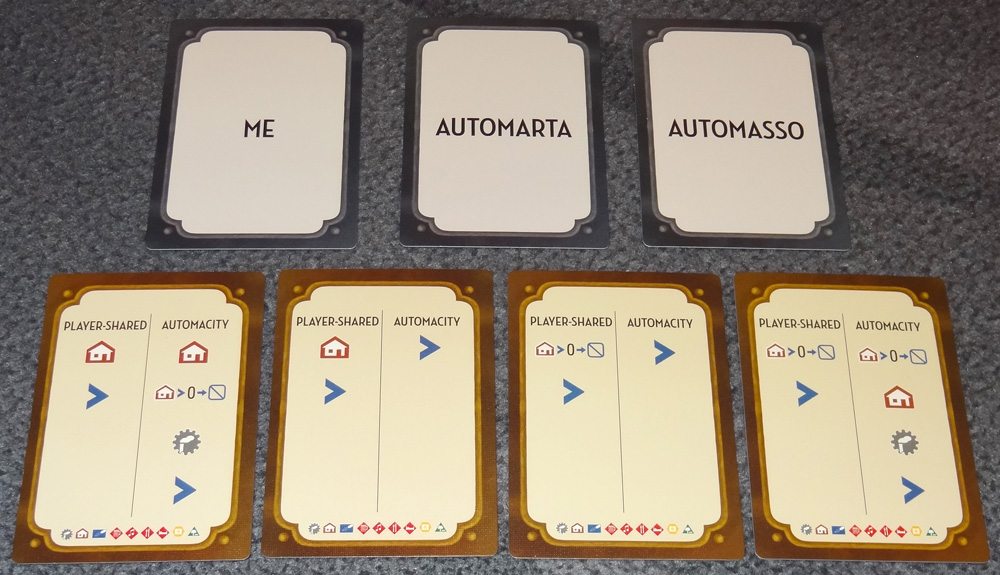
The Full solitaire version incorporates the Automa cards and the Name cards. The Name cards are simply to keep track of which tiles belong to which player: Me, Automarta, and Automasso. Instead of shuffling stacks of tiles around on the table, you can just have all the tiles organized in front of you, and swap Name cards around instead. The Automa cards are used to determine which tiles the automas choose for their cities.
The left column of the Automa card shows what the automa chooses for the city it shares with you. The right column shows what tile the automa chooses for the city it shares with the other automa. At the bottom is a row of icons indicating a priority order of tile types if there is a tie of some sort.
First, you’ll add two duplex tiles to Automacity right from the start. Then you’ll give 7 tiles to each player. Draw a card for each Automa to determine which tiles they will place in their cities. You read the column from top to bottom, stopping when a tile is available in that automa’s hand. For instance, sometimes it will choose a house–if no house is available, then it moves to the next icon. One symbol says that if a house is already in the city, then it will choose a tile type that is not yet in the city. Finally, the blue arrow just means to pick a tile that will increase the current score by the greatest amount. In case of multiple tiles having the same net increase, you refer to the small row of symbols at the bottom.
The Automa cards are functional but, again, not much to look at. I can’t help thinking that the small row of icons across the bottom could have been bigger. And, in many cases, you’re going to resort to that “highest score” factor anyway.
In both solo versions, each player’s score is, as usual, the lower of their two cities. You can adjust the difficulty level by adding or subtracting points from Automacity.
The Verdict
Between Two Cities is still just as fun to play as it was when we reviewed it at the beginning of the year, just now with some finishing touches like a box, tile backs, and fancy custom meeples.
Typically I don’t play a lot of solo games, but I’ve noticed more game designers including them, so it seems to be a growing trend. So I tried both of the solitaire modes, even though it’s not something that would affect my opinions of the base game. The Simple mode is really quick and can be played in about 10 minutes–but it is completely randomized so the automas aren’t working very hard against you. It’s more about learning how cities are put together, and once you know the rules you can probably skip it.
The Full version is tougher to beat–the automas get maximum points for each tile in their city, and they don’t have to worry about actual placement of the tiles. But it does mean that whenever you get down to the “highest score” choice, you have to look at all the tiles in the automa’s hand and calculate the score each one would get, including bonuses. That part feels a little more tedious–something that would be really handy for an app to do for you, but having to calculate the relative scores of 5 tiles just feels a little too mathy. In a multiplayer game you might do a little bit of the math, but not for three different players.
In short, I think the solitaire rules are a good way to learn the game, but the real pleasure of playing Between Two Cities comes from getting a larger group together. I enjoy the negotiations and conversation, deciding which cities we’re building, and so on.
The difference between the regular retail edition and the Special Edition isn’t huge and generally doesn’t affect gameplay (unless your first language is German or French), so it’s mostly whether you really crave those additional custom meeples and the gold trim on the box. I think either version will be pretty satisfying as far as the game itself goes.
Between Two Cities was one of my picks for this year’s holiday gift guide, so if you’ve got a tabletop fan on your list, give this one a shot! It’s available from Amazon, or check with your local game store. Stonemaier Games still has some of the Special Edition in its web store but is sold out of the retail verison.
Disclosure: I received a review copy of the Special Edition.
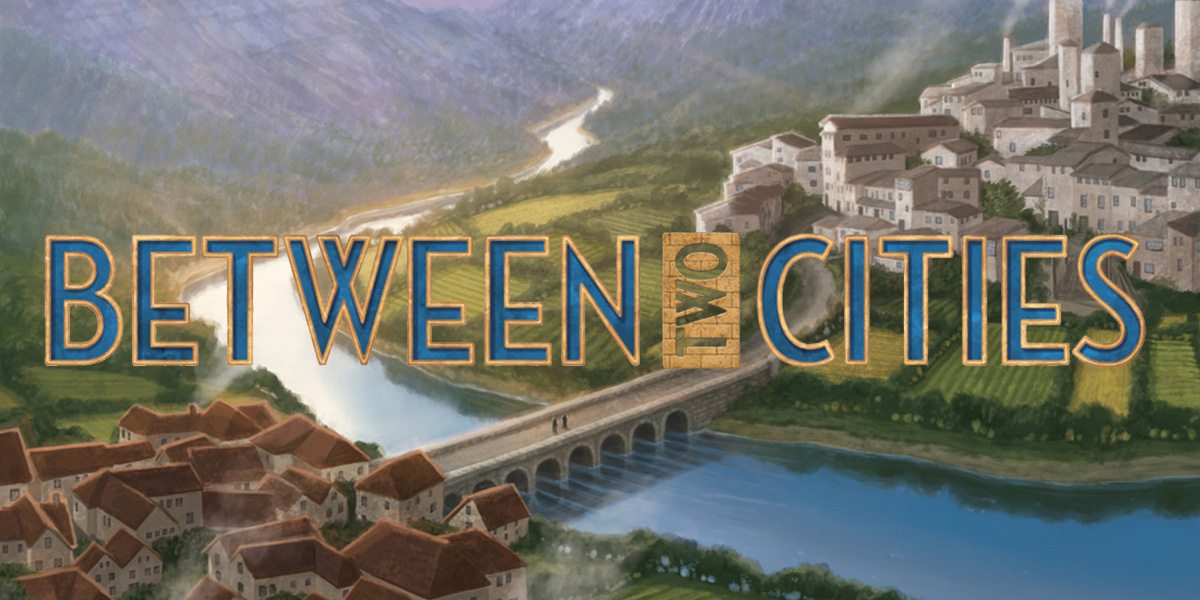

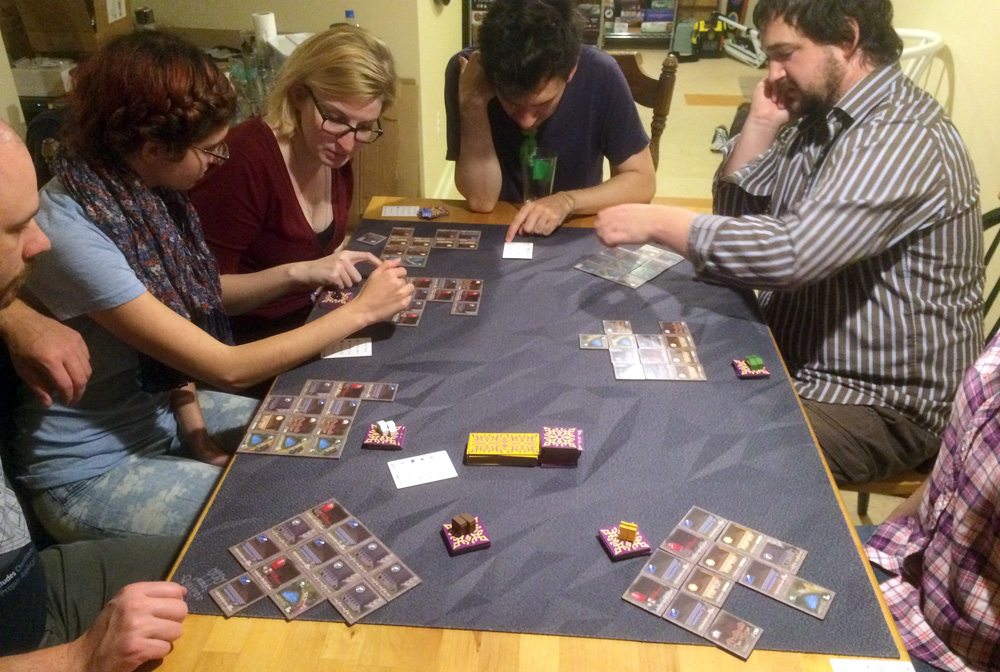




My 7 year old likes to play, he has a bit of strategy. My 5 year old likes to put the tiles wherever, at times actively working against points. overall both kids like the game and ask to play, so that is a win in my book.